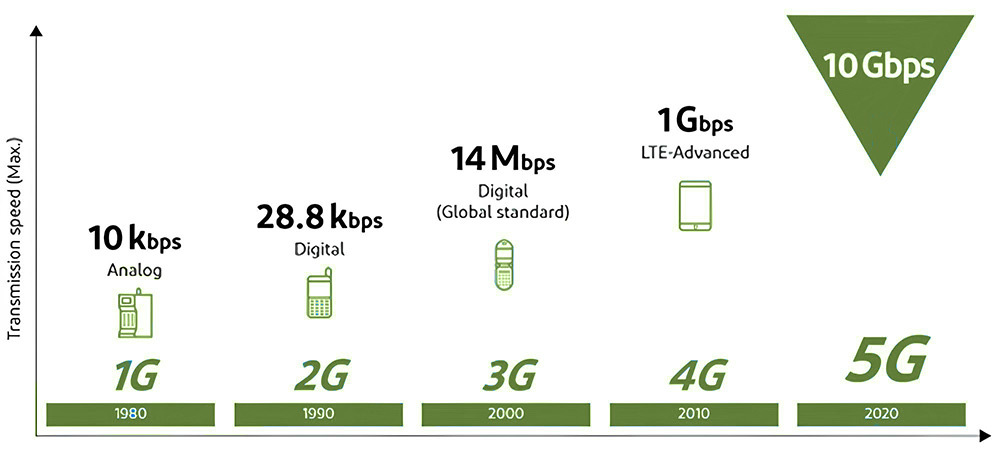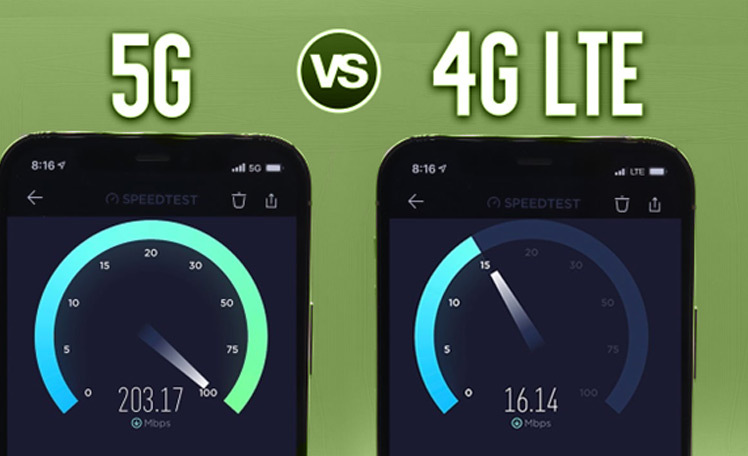5G, or fifth-generation wireless technology, is the most recent advancement in mobile network standards. It is intended to provide faster and smoother internet connectivity than previous versions, such as 4G LTE. Take an overview of the article below to find minblowing features about this network.
What is 5G?
5G refers to the fifth generation of mobile technology. This new worldwide wireless standard follows the networks of 1G, 2G, 3G, and 4G. It is a brand-new type of network designed to link almost everyone and everything, including devices, machines, and objects.
- Due to more accessible bandwidth and modern antenna technology, it will enable a major increase in the rate of data transfer across wireless networks.
- It can run on a broader range of radio frequencies, or radio waves, which gives carriers new chances to extend their network services in the midrange, extremely high frequency (EHF), and millimeter-wave (mmWave) bands.
- 5G networks have the potential to offer much higher upload and download rates than 4G networks, in addition to offering significantly lower latency.
Also, Check out Is 5G harmful to people?
How fast is 5G?

- 5G provides much higher internet speeds. Per mobile base station, peak data rates can reach up to 10Gbps uplink and 20Gbps downlink.
- Currently, 5G download rates are as high as 1,000 megabits per second (Mbps) or even as high as 2.1 Gbps.
- Movies will take minutes to download, whereas songs only take seconds
- Both video and audio are available in HD.
- When you’re connected, you can work in public spaces, share, stream, and post without being blocked by traffic.
Is 5G currently accessible?

Yes, it is already available today; in fact, in early 2019, international operators started testing out new networks. All of the big phone companies are also releasing 5G models on the market. And very soon, it might be available to even more people.
There are currently 60+ nations with 5G installations. Customers desire lightning-fast speeds and short latency. However, this network goes above and beyond such benefits by offering huge IoT, improved mobile broadband, and mission-critical services.
By 2030, 5G services will be widespread, with capabilities ranging from VR content distribution to autonomous vehicle navigation powered by real-time communications (RTC).
5G vs. 4G

Each generation of mobile phone technology differs in data transmission speed and encoding procedures, requiring end users to upgrade their hardware.
- 4G provides speeds up to 500 times faster than 3G. Whereas 5G is 100 times faster than 4G.
| Network | Peak Speed | Average Speed |
| 5G | 10Gbps | 400Mbps |
| 4G | 1Gbps | 50Mbps |
- It has a much lower latency rate than 4G.
- 4G will employ 20 MHz channels that are connected together at 160 MHz. Compared to 4G, 5G will need up to 800 MHz of channels, which means more airwave blocks will be needed.
- It can also manage all spectrum types (licensed, shared, and unlicensed) and bands (low, mid, and high), a wide range of installation patterns (from typical macro-cells to hotspots), and a variety of methods to connect.
Benefits of 5G In Future

5G is expected to transform industries and have a rapid effect on users. It can help businesses become more productive and provide consumers with greater data than ever before.
Home Internet:
The first major application is Home Internet. T-Mobile and Verizon are both selling home internet services based on their own 5G mid-band and high-band networks. Home subscribers frequently consume hundreds of megabytes per month, exceeding the capacity of our 4G networks.
Massive IoT:
This network aims to provide incredibly lean and affordable connectivity solutions by seamlessly connecting a vast number of embedded sensors in almost everything, cutting down on data rates, power, and mobility.
Robotics:
Another usage of 5G that we are beginning to see is for remote-controlled robotics and drones. Remote pilots can operate vehicles remotely with no lag because of 5G’s lower latency than 4G. Additionally, 5G’s greater bandwidth allows them to get reliable multi-camera video feeds from vehicles, so they can see where they’re going.
Healthcare:
Health care may undergo a significant transformation thanks to 5G’s ultrareliable and low-latency communications (URLLC) feature. A whole new range of possibilities arises since URLLC cuts 5G latency even more than 4G.
In the upcoming years, telemedicine, remote rehabilitation, augmented reality physical therapy, precision surgery, and even remote surgery should all see advancements.
Hospitals can build huge sensor networks to keep an eye on patients. Doctors can write smart pill prescriptions to track compliance, and insurers can even keep an eye on subscribers to figure out what procedures and treatments are acceptable.
Conclusion:
The 5G network offers much faster data rates with short response times and low energy usage. 5G provides real-time data communication, hence creating an array of new application domains. Especially in the fields of IoT, automation in factories, logistics, and networked or autonomous driving, this will help business and industry.
Read Our blog, What is Google’s Gemini AI? | Full Guide

